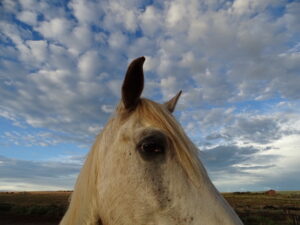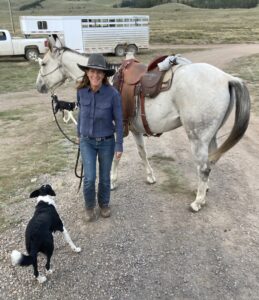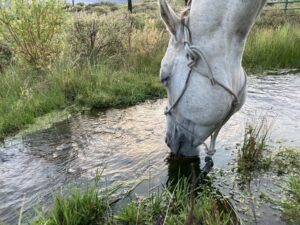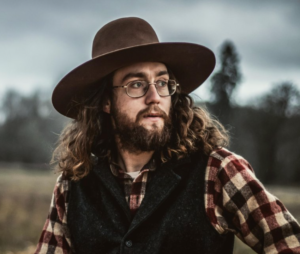Editor’s Note: This is an unedited version of a piece written about horse slaughter, animal rights activists, and rural, agrarian life. An edited and alternate version was published in the Washington Post. Thwarted by a paywall? Read it here. M.B.
Maddy Butcher writes:
They meant well.
Earlier this year, two Denver-area women had good intentions when they sponsored legislation to make it criminal to sell a horse while “reasonably” knowing it will be exported to Mexico or Canada and slaughtered for food.
Across the state line, seven Wyoming legislators, coming from another perspective, also meant well. Expressing “urgent concern” for large-scale ecological damage done by wild horses and burros, the lawmakers would like to see slaughter facilities reopened.
Before you start sending money to your favorite animal-welfare group or advocates for meat-eating, know that the Colorado effort failed (March 17) and the Wyoming resolution is largely symbolic, since it calls the US Congress to alter wild horse and burro management. Since 2007, when USDA funding for inspection of horses for slaughter was removed, there effectively has been no domestic slaughter. As for horses bound for slaughter outside the US, laws already regulate transport.
Do I wish horse slaughter in the United States were an option? Perhaps.
 But what I really want is for those detached from agrarian life to better understand animals’ existences, from first to last breaths. Policy makers should know their subject matter intimately before crafting laws that could alter the fates of animals and the people responsible for them.
But what I really want is for those detached from agrarian life to better understand animals’ existences, from first to last breaths. Policy makers should know their subject matter intimately before crafting laws that could alter the fates of animals and the people responsible for them.
A little background is in order. Today there are some 7 million horses in the United States, down from three times that many a century ago, when nearly every family had at least one horse.
In 2021, 23,431 horses were exported and slaughtered in Canada and Mexico, a sharp decrease from 2016, when over 100,000 American horses were slaughtered across borders. The number also pales in comparison with generations ago, when facilities in the United States turned hundreds of thousands of horses into canned meat.
 But in recent decades, animal welfare advocates have succeeded in convincing many that, in general, slaughter is the same as suffering. In the case of equines, advocates have apparently persuaded many that eliminating the slaughter option means American horses will live out bucolic lives until they die – old, fat and happy, under a shade tree in a green pasture.
But in recent decades, animal welfare advocates have succeeded in convincing many that, in general, slaughter is the same as suffering. In the case of equines, advocates have apparently persuaded many that eliminating the slaughter option means American horses will live out bucolic lives until they die – old, fat and happy, under a shade tree in a green pasture.
In reality, eliminating domestic slaughter has only shifted the misery. Now, neglect, abuse, hoarding, starvation and dehydration are pretty cruel substitutes for death by captive bolt (which renders the horse unconscious before it is bled out). If you lived rurally, if you saw what happens when people’s intentions outstretch their abilities, you would know. Years ago, even PETA understood that. In 2011, its founder said the United States should have never ended domestic slaughter. “The amount of suffering that it created exceeded the amount of suffering it was designed to stop,” she said of the slaughter ban.
Now, though, proponents of the Colorado proposal and other animal welfarists suggest that every unwanted horse should be purchased, adopted, and used in settings such as equine-assisted therapy programs. I roll my eyes. Caring for horses takes money, space, expertise and athleticism. They entered the slaughter stream because of a dearth of responsible horse owners. If there was bevy of new, responsible owners, the trips to slaughter would end. But there isn’t. So it hasn’t.
 I say to the well-intentioned horse lover: Why can’t you understand this?
I say to the well-intentioned horse lover: Why can’t you understand this?
“There’s a Disneyfication of animal lives among urban people,” said Dylan Biggs. At TK Ranch, Biggs works with A Greener World to maintain Certified Animal Welfare Approved status, which considers well-being, from birth to death. These would-be animal protectors, said Biggs, “are insulated, isolated, and separated from biological realities.”
As people get further from the mud and blood of working with animals, they are less able to distinguish good (quick) deaths from bad (slow) deaths. The perception is that death is just plain bad, and that the arbiters — ranchers, farmers and folks like me, who make decisions for the animals in our care, including when to end their lives — are grim and unfeeling.
The death-is-just-plain-bad perspective fails animals everywhere. It not only ignores biological realities, it dismisses the nuanced richness and the contemplative nature of our interwoven lives with other species.

Dylan Biggs
It’s spring in southwestern Colorado. Prairie dogs and tree buds are emerging. Meadowlarks are back. Cows are calving. Across the landscape, newborn are coming out feet first and dropping onto dirt, grass and snow.
Mostly, spring is a celebration of new life. But there is death, too. Cowboys sometimes “graft” an orphan calf to a mother that has lost its own calf. This means skinning the dead calf and placing its hide on the living calf. The cow, smelling her birth calf, is more likely to let this orphan suck. Revolting? Inhumane?
“To me, that whole process encapsulates ranching, trying to save lives,” Forrest Van Tuyl, a cowboy in eastern Washington, tells me. “Stuff is dying all the time. You still respect the animals. As a person with feelings, you don’t want them to die.”
Bearing witness to death is serious and humbling, but it does not necessarily include grief. Far from it, says Nicole Qualtieri, a Montana hunter I chatted with recently. “Hunting and thoughtful agriculture are spaces that deal with death openly and often with joy attached.” Joy means food for family and friends. Death means life.

Forrest Van Tuyl
What’s wrong with that?
I have lost horses, ducks, dogs, and chickens. I grieve less when their bodies can feed other animals, like eagles and coyotes. But even when they simply nurture the soil, out of death comes more life.
Very well and bravely written. We tend to not talk about these difficult subjects and without the discussion there can be no true understanding of the subject.